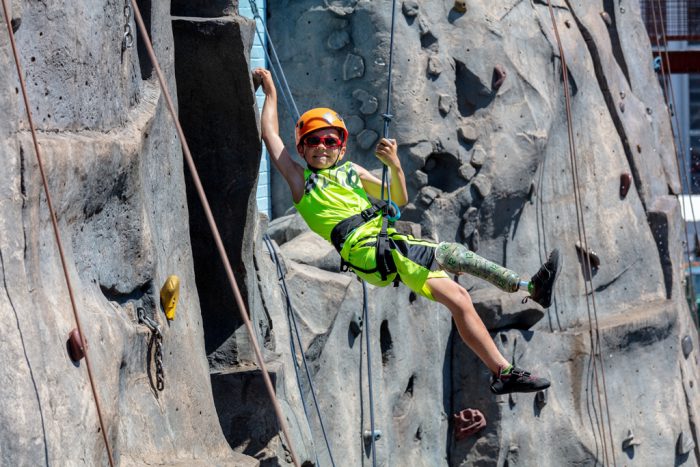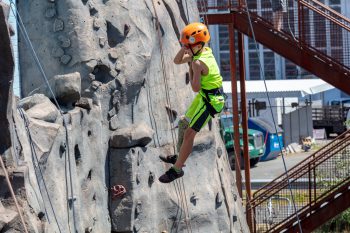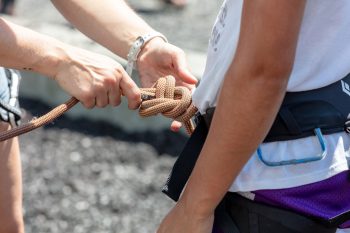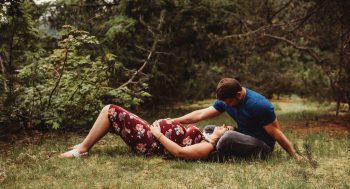
This weekend, a group of Seattle Children’s patients and families got together outside the walls of the hospital for a unique social – to climb a 30-foot rock climbing wall. For 8 years, Seattle Children’s and Outdoors for All have partnered together to allow children with limb differences the opportunity to rock climb.
Dr. Suzanne Steinman, a physician in the Hand and Upper Extremity Program who helps organize the event, says the social is a way to provide families the opportunity to get together and for kids to see they’re not alone.
“Every child who attends the event has something in common: they all have unique limbs,” said Steinman. “From congenital abnormalities of the hand or foot, to losses from amputation or trauma, kids get to see other kids with arms and legs just like theirs.”
Kenna Chapman, custom events and program manager at Outdoors for All, added, “Events like this make me feel like our work really does enrich the lives of people through recreation.”
A chance to have fun

This was the fourth year 9-year-old Ramon Little has attended the event. Within minutes, he conquered the wall and repelled down, his Seahawks themed prosthesis dangling in the air as he descended the enormous structure with a big smile on his face.
Monika Little, Ramon’s mother, found out something wasn’t quite right with her son’s foot while he was in utero. Doctors thought Ramon would be born with a clubfoot, but when he was born, he was diagnosed with tibial hemimelia, meaning he was missing a bone in his lower leg. Doctors at Seattle Children’s explained different treatment options, but recommended amputation.
“In the end, we choose function over vanity,” said Monika. “Initially, we had questions like if he’d ever be able to ride a bike. Looking back now we kind of laugh. He’s incredibly active.”
Five days after Ramon turned 1 years old, doctors at Seattle Children’s amputated his foot.
“From there we just moved forward,” said Monika. “It’s been our normal.”
By 18 months, Ramon was walking; at 3 years old he was riding a bike; by 5 years old he was learning to snowboard. Today, Ramon does gymnastics, has a black belt in taekwondo and loves to climb.
Monika says her lesson to her son has always been a simple one.
“We tell him he may be different, and that that’s a good thing,” she said. “We’ve always wanted our kids to stand out in a good way, and they do. For Ramon, there are no limits.”
Conquering walls

Abbey McPherren, 9, didn’t need any help making it to the top of the wall. It was her first time rock climbing and she made it look easy. Abbey smiled and laughed as she climbed. From the top, she coached her sister on where to put her hands and feet.
“She’s never thought of herself as having a disability,” said Abbey’s mother, Melissa McPherren. “She’s a determined go-getter.”
When Melissa was 20 weeks pregnant she was told her daughter was missing a hand.
“It was just cosmetic,” said Melissa. “She can do anything.”
Today, Abbey is a talented competitive gymnast and a natural at rock climbing.
A community of support

Nicole Stockert watched with a smile as children as young as 5 years old climbed the rock walls. She lovingly placed her hand on her stomach and envisioned the active life her son would have one day. Stockert is 36 weeks pregnant and expecting her first child, a baby boy. She came to the event hoping to meet other families from Seattle Children’s who have children with limb differences.
At 14 weeks, she and her husband found out their baby would be born with symbrachydactyly. He’s missing his left hand. They were prenatally diagnosed and already have an appointment scheduled at Seattle Children’s with Steinman five days after their delivery date.
“When we found out it was devastating,” said Stockert. “You want to hear your baby is going to be healthy and perfect. It’s hard to hear anything different.”
Initially, Stockert said they were scared and didn’t know what to expect. Thinking about their son’s future was difficult. Stockert said her husband, who is very active, wondered if he’d be able to play catch with his son.
“We went through a grieving process,” said Stockert.
Surrounded by a supportive community, Stockert says she feels more at ease now. Seeing children running, jumping, climbing and laughing was just what the doctor ordered. She can imagine her son in their shoes.
“He’s going to be perfect,” said Stockert.
Throughout the event, families mingled with Stockert offering their own stories and experiences.
“Welcome to the family,” said Steinman.
For Steinman and other members of the Orthopedics and Sports Medicine team at Seattle Children’s who put together the event every year, this is what the social is all about.
“We can give medical information to patients and families, but we’re not living it,” said Sharon Greenberg, an occupational therapist at Seattle Children’s. “Each family can offer a unique perspective we can’t.”
“For me, this is one of the most satisfying experiences of my job,” said Sue Robinson, an orthopedic nurse for Dr. Vincent Mosca and Lower Limb Differences Program coordinator. “Bringing families together and seeing kids be inspired to do something like climbing is really great.”
Looking around the room, no one saw children with differences. It was a room full of children with endless opportunities.

